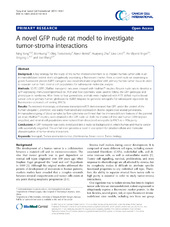| dc.contributor.author | Yang, Ning | en_US |
| dc.contributor.author | Huang, Bin | en_US |
| dc.contributor.author | Tsinkalovsky, Oleg | en_US |
| dc.contributor.author | Brekkå, Narve | en_US |
| dc.contributor.author | Zhu, Huaiyang | en_US |
| dc.contributor.author | Leiss, Lina | en_US |
| dc.contributor.author | Enger, Per Øyvind | en_US |
| dc.contributor.author | Li, Xingang | en_US |
| dc.contributor.author | Wang, Jian | en_US |
| dc.date.accessioned | 2015-02-17T13:11:08Z | |
| dc.date.available | 2015-02-17T13:11:08Z | |
| dc.date.issued | 2014-12-21 | eng |
| dc.identifier.issn | 1475-2867 | |
| dc.identifier.uri | https://hdl.handle.net/1956/9396 | |
| dc.description.abstract | Backgroud: A key strategy for the study of the tumor microenvironment is to implant human tumor cells in an immunodeficient rodent strain ubiquitously expressing a fluorescent marker. Here, a novel nude rat expressing a green fluorescent protein (GFP) transgene was established and engrafted with primary human tumor tissue in order to separate tumor from stromal cell populations for subsequent molecular analysis. Methods: SD-TG (GFP) 2BalRrrc transgenic rats were crossed with HsdHan™: rnu/rnu Rowett nude rats to develop a GFP expressing immunocompromised rat. PCR and flow cytometry were used to follow the GFP genotype and phenotype in newborns. After three to four generations, animals were implanted with 4 T1 dsRed murine breast cancer cells or primary human glioblastoma (GBM) biopsies to generate xenografts for subsequent separation by fluorescence-activated cell sorting (FACS). Results: Fluorecence microscopy and reverse transcription-PCR demonstrated that GFP, under the control of the human ubiquitin C promoter, was stably maintained and expressed in diverse organs over several generations. Immunophenotyping of blood samples by flow cytometry confirmed that the immunodeficient features of the parental rat strain, HsdHan™: rnu/rnu, were retained in the GFP nude rat. Both the murine cell line and human GBM biopsies engrafted, and stromal cell populations were isolated from dissociated xenografts by FACS to > 95% purity. Conclusions: A GFP transgene was stably introduced into a nude rat background in which human and murine cancer cells successfully engrafted. This animal strain provides a novel in vivo system for detailed cellular and molecular characterization of tumor-stroma interactions. | en_US |
| dc.language.iso | eng | eng |
| dc.publisher | BioMed Central | eng |
| dc.rights | Attribution CC BY | eng |
| dc.rights.uri | http://creativecommons.org/licenses/by/4.0 | eng |
| dc.subject | Xenograft | eng |
| dc.subject | Tumor-stroma interaction | eng |
| dc.subject | Glioblastoma | eng |
| dc.subject | Breast cancer | eng |
| dc.subject | Tumor biology | eng |
| dc.title | A novel GFP nude rat model to investigate tumor-stroma interactions | en_US |
| dc.type | Peer reviewed | |
| dc.type | Journal article | |
| dc.date.updated | 2015-02-05T16:04:51Z | |
| dc.description.version | publishedVersion | en_US |
| dc.rights.holder | Copyright 2014 Yang et al.; licensee BioMed Central | |
| dc.rights.holder | Ning Yang et al.; licensee BioMed Central Ltd. | |
| dc.source.articlenumber | 541 | |
| dc.identifier.doi | https://doi.org/10.1186/s12935-014-0146-0 | |
| dc.source.journal | Cancer Cell International | |
| dc.source.40 | 14 | |

